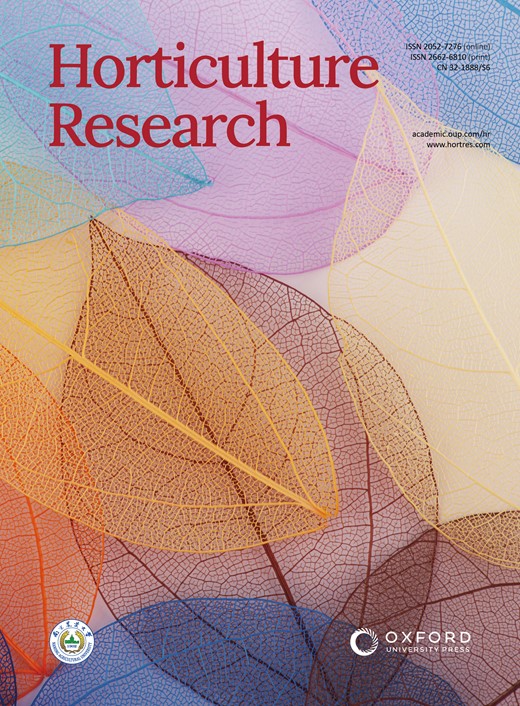CsNAC17 通过与山茶中的 CsbHLH62 相互作用,增强山茶对球孢子菌的抗性
IF 8.7
1区 农林科学
Q1 Agricultural and Biological Sciences
引用次数: 0
摘要
病原体球孢子菌(Colletotrichum gloeosporioides)会引起炭疽病,严重威胁世界各地的茶树,尤其是温暖潮湿地区的茶树。之前的 RNA-Seq 数据表明,NAC 转录因子参与了炭疽病的抗性,但其潜在机制仍不清楚。BiFC、Split-LUC 和 Co-IP 试验验证了通过酵母双杂交(Y2H)筛选确定的 CsbHLH62 和 CsNAC17 之间的相互作用。CsNAC17 或 CsbHLH62 的过表达增强了烟草菌的抗炭疽病能力,同时也增强了烟草菌的 H2O2 水平、超敏性和细胞死亡。NBS-LRR 基因 CsRPM1 受 CsNAC17 的调控,直接与其启动子结合(即 CACG、CATGTG),而 CsbHLH62 可促进 CsNAC17 的结合并提高 CsRPM1 的转录活性。此外,利用病毒诱导基因沉默(VIGS)系统在茶树叶片中瞬时沉默 CsNAC17 和 CsbHLH62 会降低茶树对炭疽病的抗性。相反,CsNAC17 和 CsbHLH62 在茶叶中的瞬时过表达则显著增强了茶叶对炭疽病的抗性。基于这些结果,CsbHLH62 似乎促进了 CsNAC17 对 CsRPM1 的活性,从而提高了炭疽病的抗性。本文章由计算机程序翻译,如有差异,请以英文原文为准。
CsNAC17 enhances resistance to Colletotrichum gloeosporioides by interacting with CsbHLH62 in Camellia sinensis
The pathogen Colletotrichum gloeosporioides causes anthracnose, a serious threat to tea trees around the world, particularly in warm and humid regions. RNA-Seq data have previously indicated NAC transcription factors are involved in anthracnose resistance, but underlying mechanisms remain unclear. The BiFC, Split-LUC, and Co-IP assays validated the interaction between CsbHLH62 and CsNAC17 identified through yeast two-hybrid (Y2H) screening. CsNAC17 or CsbHLH62 overexpression enhanced anthracnose resistance, as well as enhanced levels of H2O2, hypersensitivity, and cell death in Nicotiana benthamiana. The NBS-LRR gene CsRPM1 is regulated by CsNAC17 by binding directly to its promoter (i.e., CACG, CATGTG), while CsbHLH62 facilitates CsNAC17’s binding and increases trascriptional activity of CsRPM1. Additionally, transient silencing of CsNAC17 and CsbHLH62 in tea plant leaves using the virus-induced gene silencing (VIGS) system resulted in decreased resistance to anthracnose. Conversely, transient overexpression of CsNAC17 and CsbHLH62 in tea leaves significantly enhanced the resistance against anthracnose. Based on these results, it appears that CsbHLH62 facilitates the activity of CsNAC17 on CsRPM1, contributing to increased anthracnose resistance.
求助全文
通过发布文献求助,成功后即可免费获取论文全文。
去求助
来源期刊

Horticulture Research
Biochemistry, Genetics and Molecular Biology-Biochemistry
CiteScore
11.20
自引率
6.90%
发文量
367
审稿时长
20 weeks
期刊介绍:
Horticulture Research, an open access journal affiliated with Nanjing Agricultural University, has achieved the prestigious ranking of number one in the Horticulture category of the Journal Citation Reports ™ from Clarivate, 2022. As a leading publication in the field, the journal is dedicated to disseminating original research articles, comprehensive reviews, insightful perspectives, thought-provoking comments, and valuable correspondence articles and letters to the editor. Its scope encompasses all vital aspects of horticultural plants and disciplines, such as biotechnology, breeding, cellular and molecular biology, evolution, genetics, inter-species interactions, physiology, and the origination and domestication of crops.
 求助内容:
求助内容: 应助结果提醒方式:
应助结果提醒方式:


